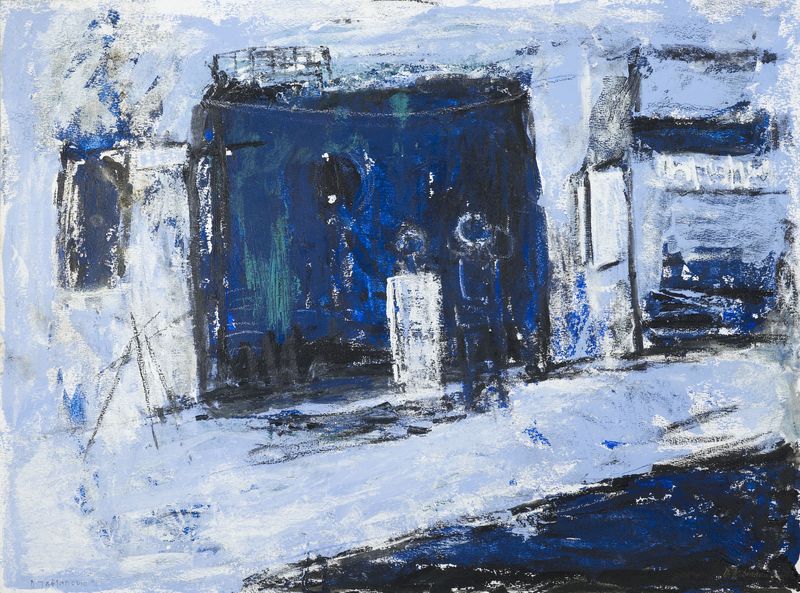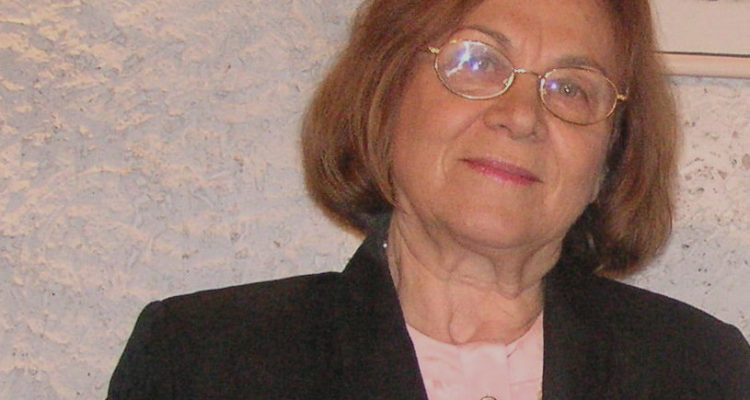“Color can best express me and my personality.”
Paul Zimmerman in conversation with Dusanka Jablanovic
PZ: You work in various mediums. How do you choose a particular one for your new work?
DJ: It depends on my current mood and inspiration. For the printmaking medium I need time for preparations – for sketches, for selection of print paper and print colors, for decision about mix-media techniques. In general, all the working process, including printing on printing press, takes a little bit long. But for me every step of it is so exciting. When it comes to painting, especially when I work in acrylic, then it’s always instant inspiration, instant impression and emotion, so I work quickly, spontaneously and directly, usually without a sketch or preparation. Collages are also made spontaneously, but their realization is a process, so for them, too, I need preparation time – to collect all the elements and to arrange them in creating and visualizing my idea.
PZ: Most of your pieces are abstract. When did you develop interest in reshaping objective reality into abstraction?
DJ: My interest in abstraction grew around 1985 when I started attending a special painting course in Zurich with Professor Ernst Faesi. That’s when I started looking at the world around me with different eyes. I focused on detail and on the essentials, reducing descriptiveness. The colors no longer reflected what I saw, but what I felt. I no longer described the motif, but structured it. Sometimes I was inspired by a part of a well-known abstract painting from which I would start, and then incorporated it in my vision and in my painting idiom.
PZ: What is the role of color and shape in your paintings?
DJ: Color plays a big role in my work, especially in painting. But it became dominant in my later creative phase. In my early works the main was line and drawing. When color prevailed, it became the main means of expressing my emotions, my dreams, hopes, pains, and defiance. I prefer red when I want to express love – but also when I want to express rebellion; yellow to express happiness, hope and light in life; and my favorite blue to express pain, sorrow, nostalgia and helplessness – but also dreaminess and spirituality. Color can best express me and my personality: all my visions and experiences, desires and memories. If speaking about the form and the motif that inspired me the most, then I say the stone was my obsession for a long time. Its shapes and colors always fascinated me and I consider it a metaphor for the universe.
Another form and motif that inspired me greatly was the flower, which I modified and abstracted over the years, turning it at the end into the symbol.
PZ: How do you define yourself as an artist?
DJ: If I want to describe myself as an artist, then I can say I am a contemporary printmaker and an expressionist painter. As a printmaker, I am a researcher who loves to experiment with printing techniques, new approaches and new procedures. In my graphic works I always use mix-media, combining traditional printmaking techniques, such as etching, or lithography with chine colle, collages, collagraphs, photography and even drawings. I also like the polymer and photopolymer technique, as well as print on textile surfaces. I can say that when experimenting I use the benefits of my other profession – the chemical engineer, cause in the printmaking process I apply the knowledge I mastered from the study of chemical technology.
As a painter I express myself as a color and gesture expressionist. Bringing into my painting – especially into color and ever-present gestural brush stroke all my emotions, memories and experiences, my happy and difficult life moments, delights and personal tragedies (loss of my son). But also bringing into it my poetics, enthusiasm, persistence and positive energy, which always leaves the universal, humanistic message.

Street, 2002, acrylic on canvas, 22″ x 30″
PZ: You are a Croatian born artist living in Switzerland. How these two cultures impact your vision?
DJ: I think both my homelands, Croatia and Switzerland, have strongly influenced my artistic creation, each in their own way. And both are my constant inspiration. My artistic personality was certainly marked by a happy early childhood in Croatia. Childhood in a small town, where I was daily in the close contact with nature. It was at this time that I began to draw portraits and landscapes, filling with them a multitude of school blocks and notebooks. But everything was interrupted when the Second World War broke out. After the war my life took a different direction for a while: moving to Zagreb, studying natural sciences, degree in chemistry, and then employment, family, children, life problems …
Coming to Switzerland re-opened for me the door to art. In Zurich I began and completed art education in printmaking and painting – and soon after that began exhibiting. I also intensified my communication in the field of art and culture, by meeting with artists, visiting studios, visiting museums and galleries, attending symposia…But at the same time, I used to retreat into the peace and quiet of my own studio and paint. Paint a lot! Today, when I look at my entire opus, I can say that in Croatia my artistic spark was ignited, but in Switzerland it erupted. I have been living in Switzerland for five decades now, but I also visit Croatia regularly all the time, building my artistic career in both homelands: collaborating with curators and art critics, exhibiting works of art and publishing books. And in both homelands I am at home.
PZ: How did you become interested in art?
DJ: From an early age I had a constant need to draw. To draw everything, everyone and on every occasion. I drew at school during class, in school blocks, or on the edges of notebooks, and portrayed my schoolmates and friends. Later, I portrayed my entire family, especially my children, with a pencil, ink, watercolour. I can say that generally, in my early art phase, I loved to draw children and at my travels I made many of their portraits with pencil and ink.
During my studies in Zagreb I intensified my visits of museums, galleries, exhibitions, but also theater performances, concerts and literary events, thus melting with participants of the wide art scene. With the world to which I have always inclined. After moving to Switzerland I completely immersed into that world, first learning from top masters of printmaking and painting, and then affirming myself as a professional artist, who has now been active, I can say for decades.
PZ: Did your practice change over time?
DJ: Yes, of course. My artistic expression and my painting style have changed over time in both media, depending on my current interests, my research and my studies of contemporary materials and procedures, but also depending on my new discourse that have brought new themes, new concepts and new approaches. Sometimes the change was caused by some external factor – a current event or a global catastrophe, which then provoked my visual reaction, usually with the note of criticism, provocation, or satisfaction.
PZ: Which artists are you most influenced by?
DJ: In the beginning, in my early printmaking, my biggest inspiration was Michelangelo. At the same time, when working on the portraits, I was greatly inspired by Botticelli and his beautiful, refined female faces. Meštrović’s female figures were my inspiration at the time when I introduced the motif of a sad woman into my artworks, which was a reflection of tragic events in my personal life. Later, my work, especially painting, was significantly influenced by the works of famous European painters of the modern age, primarily Cezanne and Matisse, but above all the works of expressionists of the Bridge group – Franz Marc, Gabrielle Munther, Karl Schmidt Rottluff and Ernst Ludwig Kirchner. Of course, the works of Vasily Kandinsky, too. In the period 1990-2000, when I had my symbolic and metaphysical phase in painting, I was strongly influenced by the works of Marc Chagall, Odilon Redon and Kurt Schwitters.
PZ: What are you working on now?
DJ: I am currently making large and small format collages. They are a kind of recycling art, because they are a combination of a painting on canvas, made in acrylic, and parts of earlier graphic prints (polymers), which are glued to the painting forming a geometric pattern. I have just completed one such work – a large painted canvas, to which I glued about 30 small graphic prints that extend radially from the center of the painting to the edges. In my vision they look like nowdays pandemia virus that spreads in all directions
PZ: How does this pandemic affect your work and sensibility?
DJ: The effects of this corona virus pandemic has reminded me of the stressful events of World War II I remember from my childhood – of the fear and hopelessness. They also has reminded me of all the horrors and anxieties of the war in my homeland Croatia 1990-1995. Now I am wondering if I will have to relive it all again. In 1992 I painted a painting called Apocalypse, inspired by the horrors of the war in Croatia, just as Coppola, in 1979, inspired by the war in Vietnam, made a film called Apocalypse Now. At the beginning of this corona virus pandemic I painted a black flower and a large black bird above it. But still, I did not paint a new picture of the Apocalypse. In these present times of uncertainty I have discovered, however, the importance of ordinary, small things, the beauty of nature, and the value of life. I have now decided to spend more time in my garden, observing the flower, the grass, the tree, the stream, the sky, the birds, the wind … thus being in closer communication with nature, but with myself too. And that helps me. So now I can see the importance of what seemed unimportant to me before. I can see the value of life, but also the relativity of the relation of small and big, which from the perspective of the universe becomes irrelevant.
